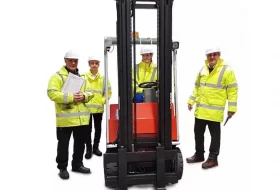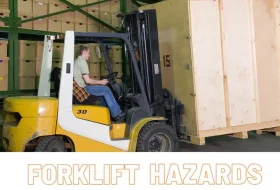Forklifts account for 25% of injuries at work. So many accidents take place every year at forklift job sites related to dealing with dangerous goods. We all should adopt practices that help prevent such hazards. In this blog, we will lay out important statistics and provide a safety guide for working with dangerous goods on forklifts. If you want to become a professional forklift operator, you must undergo the best WHMIS training in Mississauga. You will stand a fair chance to learn the required health and safety legislation as well as hands-on experience with forklift machines. Moreover, you will also learn to safely deal with dangerous or toxic substances while transporting them to one place from another.
Forklifts are extremely useful workplace vehicles as long as they are used safely and appropriately. We all are truly aware of the fact that operating a forklift involves so many risks, even when moving simple products. But imagine the amount of risk movement of dangerous goods involves. A minute spill can result in serious injury.
To-Do list to consider while carrying dangerous goods on forklifts
- It is important to label dangerous goods with danger signages.
- Always wear protective gear as recommended in the OSHA safety guidelines. It includes a hard hat, hard footwear, and radium jackets when working around forklifts carrying dangerous goods to transport.
- Always reach your supervisor in case of any doubt.
- Ensure your path is free of obstructions especially when carrying dangerous goods on forklifts.
- Watch out for pedestrians.
- Travel at a slightly slower speed as prescribed for the location and the load carried. Slow down a little more when you come across corners, blind spots, and blind spots. Use a horn whenever necessary.
- It is important to check the weight, size, & load. Ensure the load is at the center. Check safe working load before placing the loads on the forklift.
- While dealing with dangerous goods, make sure the load doesn’t block your view. In case it does, you need to drive in reverse.
- Ensure you have personally dealt with dangerous goods before or try to work under experienced supervision. It is really important to be properly trained, certified, and authorized to deal with dangerous goods.
- Dealing with dangerous goods becomes critical when you have to travel down or up the slopes. The chances of spills increase when traveling upside or downside.
- Adjust the tilt according to the requirements and suit the gradient.
- When reaching the destination, ensure you park your forklift safely and hand over dangerous goods to the next assigned candidate.
Not-To-Do list to consider while carrying dangerous goods on forklifts
- Never try to transport dangerous goods on your own unless you are trained, competent, and authorized to do so.
- Never transport dangerous chemicals on forklifts that aren’t working properly as they hold the potential to cause an accident.
- Do not brake harshly and never start or stop a forklift suddenly as it might result in chemical spillage, causing serious injuries at the workplace. Also, refrain from making abrupt turns.
- Do not run over wires or leftover objects at the pathway.
- Do not use mobile phones and try not to get distracted by the surroundings.
- Do not try to carry out repairs when dangerous goods are fully loaded, rather shift the goods to another forklift.
- Never overload your forklift truck with dangerous goods.
- Never leave the forklift with dangerous chemicals unattended.
- Refrain to turn the vehicle around or across when carrying the sensitive load on slopes.
- Never ever lift too many operators along with you while transporting goods as this might result in a serious accident.
Employers must conduct regular maintenance of the forklift to reduce all types of accidents and injuries at the workplace. Also, improve safety practices by providing appropriate training to the operators. Spills can happen anywhere so everyone involved in the process must stay prepared with the precautions and post-hazard solutions. Here’s what you can do once the water is over the neck:
- Identify the spilled substance
- Report the spill
- Evacuate the area
- Use life safety
- Check if all are safe
- Decontaminate the area
- Do the paperwork
- Restock supplies
- Take preventive measures
To learn more about forklift driving and operator training, you can get connected with us at 905-621-2222. Better yet, get certified today.




